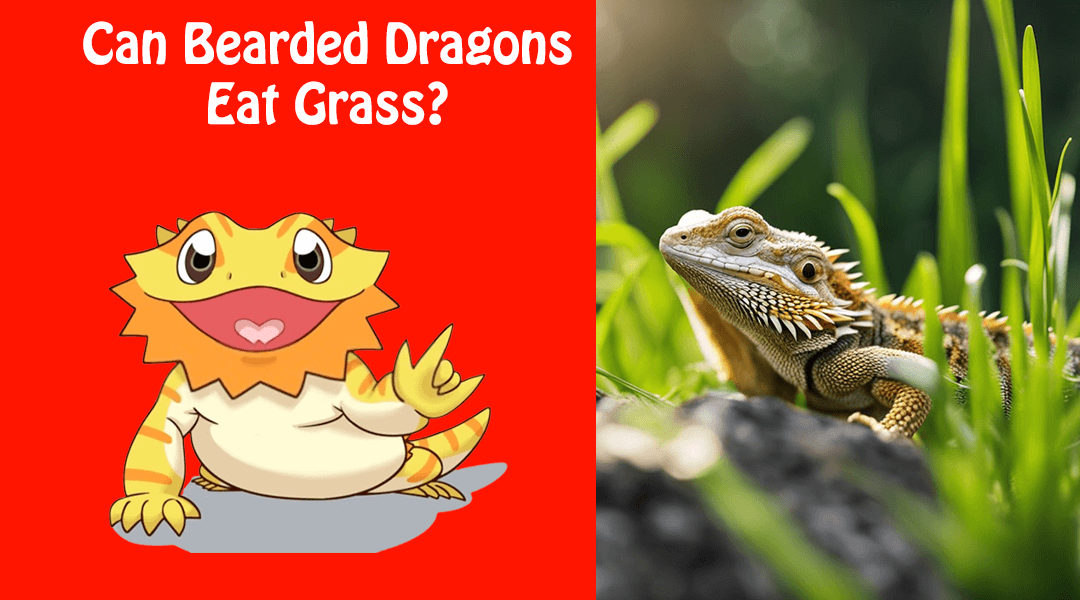Bearded dragons are a popular pet reptile known for their docile temperament and unique appearance. As omnivores, they require a balanced diet of both animal protein and plant matter to thrive. While many fruits and vegetables are safe and healthy for bearded dragons to eat, there is some confusion surrounding whether or not they can consume grass.
Grass is a common plant found in many outdoor environments, and bearded dragons may come into contact with it during outdoor playtime or while foraging for food. Some owners may wonder if it is safe to feed their bearded dragon grass as part of their regular diet. In this article, we will explore whether or not bearded dragons can eat grass, and if so, what precautions should be taken to ensure their health and safety.
Bearded Dragons Diet Fundamentals
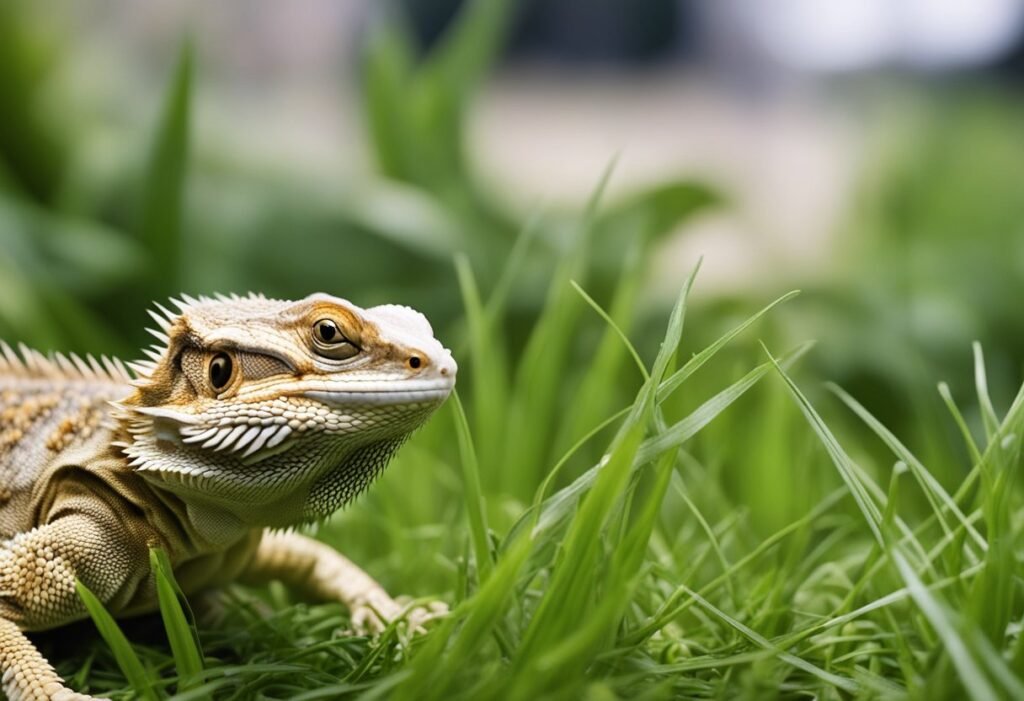
Nutritional Needs
As responsible pet owners, we need to ensure that our bearded dragons receive a balanced and nutritious diet. Bearded dragons are omnivores, which means they require a mix of both plant and animal-based foods. A healthy diet for a bearded dragon should consist of 80% vegetables and 20% insects.
Bearded dragons require a variety of nutrients to maintain good health. These include protein, calcium, phosphorus, vitamins, and minerals. It is essential to provide a balanced diet that meets all of these nutritional requirements.
Safe Foods for Bearded Dragons
When it comes to feeding bearded dragons, not all foods are created equal. Some foods can be harmful to them, while others are safe and nutritious. Here are some examples of safe foods that you can include in your bearded dragon’s diet:
- Vegetables: collard greens, kale, mustard greens, turnip greens, dandelion greens, bok choy, butternut squash, bell peppers, carrots, and sweet potatoes.
- Insects: crickets, mealworms, waxworms, and dubia roaches.
- Fruits: strawberries, blueberries, blackberries, raspberries, mangoes, and papayas.
It is important to note that not all vegetables and fruits are safe for bearded dragons. Some vegetables, such as spinach and iceberg lettuce, contain high levels of oxalates, which can bind to calcium and prevent its absorption. Fruits that are high in sugar, such as grapes and bananas, should also be avoided.
In conclusion, a balanced and nutritious diet is essential for the health and well-being of your bearded dragon. By providing a variety of safe foods, you can ensure that your pet receives all of the nutrients they need to thrive.
Understanding Grass Varieties
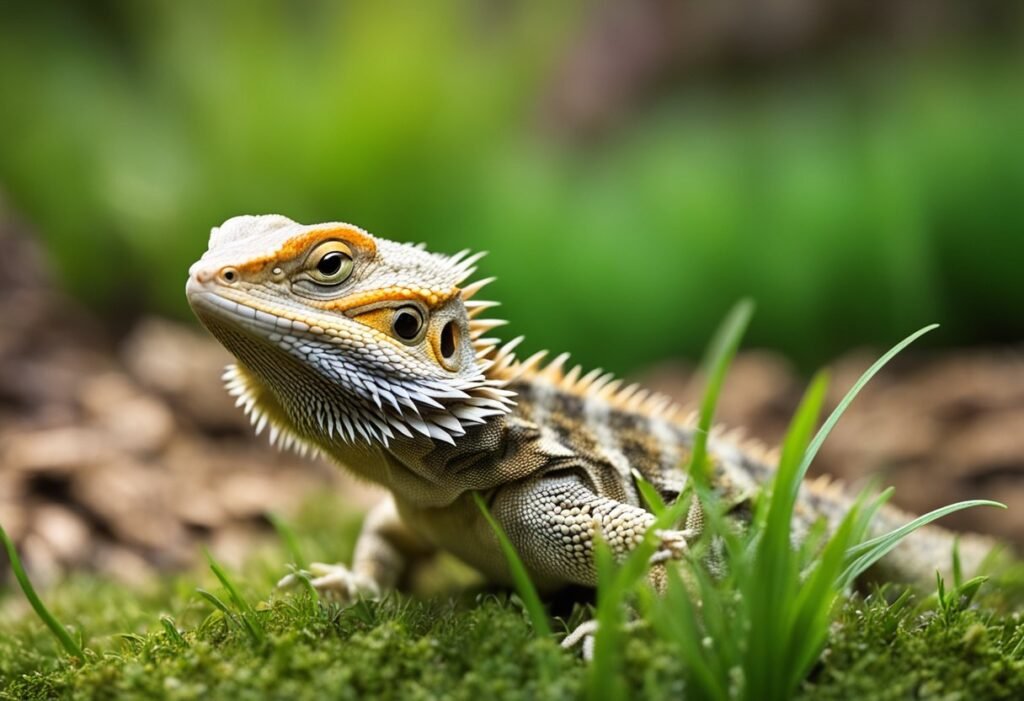
When considering whether or not to feed grass to your bearded dragon, it is important to understand the different types of grass and which ones are safe for consumption. In this section, we will examine the various grass varieties and provide information on which ones are edible for bearded dragons.
Edible Grass Types
There are several types of grass that are safe for bearded dragons to eat. These include:
- Bermuda grass
- Timothy grass
- Orchard grass
- Wheatgrass
Bermuda grass is a common type of grass that is often used in lawns and is safe for bearded dragons to consume. Timothy grass is another popular grass that is safe for bearded dragons and is often used as hay for livestock. Orchard grass is another safe option for bearded dragons and is often used as a forage crop for livestock. Wheatgrass is also safe for bearded dragons and is often consumed by humans as a health supplement.
Grass to Avoid
While there are several types of grass that are safe for bearded dragons to eat, there are also several types of grass that should be avoided. These include:
- Ryegrass
- Fescue grass
- Bluegrass
- Kentucky bluegrass
Ryegrass, fescue grass, and bluegrass are all types of grass that are commonly used in lawns and should not be fed to bearded dragons as they can cause digestive issues. Kentucky bluegrass is another type of grass that should be avoided as it contains high levels of oxalates, which can be harmful to bearded dragons.
In conclusion, when considering feeding grass to your bearded dragon, it is important to understand the different types of grass and which ones are safe for consumption. Stick to the safe options, such as Bermuda grass, Timothy grass, Orchard grass, and Wheatgrass, and avoid the harmful ones, such as Ryegrass, Fescue grass, Bluegrass, and Kentucky bluegrass.
Health Benefits of Grass for Bearded Dragons
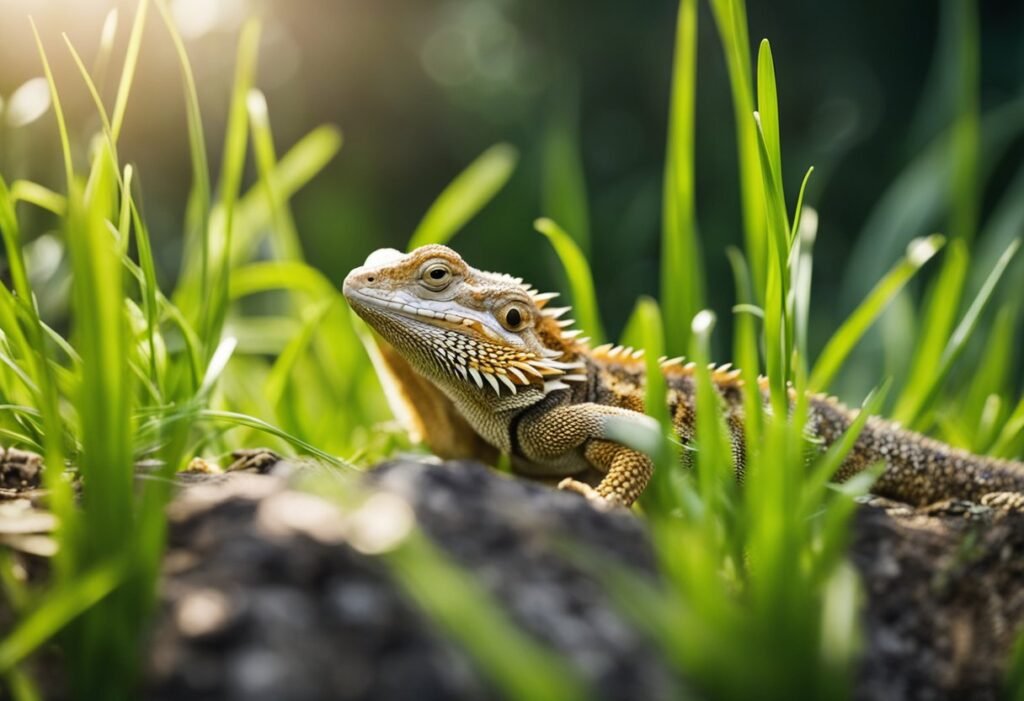
Grass can be a great addition to a bearded dragon’s diet. It is a good source of fiber and can help prevent constipation. In addition, grass contains essential nutrients that can help keep your pet healthy.
Here are some of the health benefits of grass for bearded dragons:
1. Fiber
Grass is a good source of fiber, which is important for digestion. Fiber helps move food through the digestive system and prevents constipation. Bearded dragons that don’t get enough fiber can develop impaction, a serious condition that can be fatal.
2. Nutrients
Grass contains essential nutrients that can help keep your bearded dragon healthy. It is a good source of vitamins A and C, which are important for immune function and skin health. Grass also contains calcium and phosphorus, which are important for bone health.
3. Enrichment
Eating grass can also provide enrichment for your bearded dragon. Bearded dragons in the wild spend a lot of time foraging for food, and providing grass for your pet to eat can help simulate this natural behavior.
However, it’s important to note that not all grass is safe for bearded dragons to eat. Some grasses can be toxic or contain pesticides. Always make sure the grass you are feeding your bearded dragon is safe and free from any harmful chemicals.
In conclusion, grass can be a great addition to a bearded dragon’s diet. It provides fiber, essential nutrients, and enrichment. However, always make sure the grass you are feeding your pet is safe and free from any harmful chemicals.
Risks of Feeding Grass to Bearded Dragons
When it comes to feeding bearded dragons, it’s important to provide them with a balanced diet that meets their nutritional needs. While grass may seem like a harmless addition to their diet, there are some risks to consider.
Firstly, grass may contain pesticides or other chemicals that can be harmful to bearded dragons. It’s important to ensure that any grass fed to your bearded dragon is free from chemicals and has not been treated with pesticides.
Secondly, grass is not a significant source of nutrition for bearded dragons. While it may provide some fiber, it does not contain the essential vitamins and minerals that bearded dragons need to thrive.
Thirdly, bearded dragons may have difficulty digesting grass. This can lead to digestive issues such as impaction, which can be a serious health concern for bearded dragons.
In conclusion, while feeding grass to bearded dragons may seem like a natural and harmless addition to their diet, it’s important to consider the potential risks. It’s best to stick to a balanced diet that includes commercial bearded dragon food, fresh vegetables, and occasional treats such as insects.
How to Introduce Grass to Your Bearded Dragon’s Diet
We all know that bearded dragons are omnivores and require a balanced diet to thrive. While they primarily feed on insects and vegetables, introducing grass to their diet can provide additional nutrients and fiber. However, it’s important to introduce grass gradually to avoid digestive issues.
Here are some steps to follow when introducing grass to your bearded dragon’s diet:
- Choose the right type of grass: Not all grass is safe for bearded dragons. It’s best to choose grass that hasn’t been treated with pesticides or herbicides. Bermuda grass, Timothy grass, and wheatgrass are safe options.
- Wash the grass: Before feeding grass to your bearded dragon, wash it thoroughly to remove any dirt or debris that may be harmful.
- Cut the grass into small pieces: Bearded dragons have small mouths, so it’s important to cut the grass into small pieces. This will make it easier for them to chew and digest.
- Introduce grass gradually: Start by offering a small amount of grass once a week and gradually increase the amount over time. This will allow your bearded dragon’s digestive system to adjust to the new food.
- Monitor your bearded dragon’s behavior: After introducing grass to your bearded dragon’s diet, monitor their behavior for any signs of digestive issues. If your bearded dragon experiences diarrhea or constipation, reduce the amount of grass in their diet.
By following these steps, you can safely introduce grass to your bearded dragon’s diet and provide them with additional nutrients and fiber. Always remember to consult with a veterinarian if you have any concerns about your bearded dragon’s diet.
Preparing Grass for Consumption
When it comes to feeding your bearded dragon, grass can be a great source of fiber and nutrients. However, before serving grass to your pet, it is important to properly prepare it to ensure it is safe and healthy for consumption.
Washing and Cleaning
Before serving grass to your bearded dragon, it is important to thoroughly wash and clean it. Grass can easily collect dirt, pesticides, and other harmful substances that can be harmful to your pet. We recommend washing the grass under running water and using a vegetable brush to scrub away any dirt or debris. If you are unsure about the safety of the grass, it is best to avoid feeding it to your pet.
Cutting and Serving Sizes
When feeding grass to your bearded dragon, it is important to cut it into small, bite-sized pieces. This will make it easier for your pet to eat and digest. We recommend cutting the grass into pieces that are no larger than the width of your pet’s head. Additionally, be sure to remove any tough stems or other parts of the grass that may be difficult for your pet to eat.
In summary, grass can be a healthy addition to your bearded dragon’s diet, but it is important to properly prepare it before serving. By washing and cleaning the grass and cutting it into small, bite-sized pieces, you can ensure that your pet receives all of the benefits of this nutritious food.
Monitoring Your Bearded Dragon’s Health
As responsible pet owners, it is crucial to monitor our bearded dragon’s health regularly. Here are some key indicators to watch out for:
Physical Appearance
We should observe our bearded dragon’s physical appearance regularly. Look out for any changes in their skin color, texture, or any unusual bumps or lumps. A healthy bearded dragon should have clear eyes, a plump tail, and a well-formed body.
Eating Habits
Bearded dragons are known for their voracious appetites. If our bearded dragon suddenly stops eating or shows a lack of interest in food, it could be a sign of an underlying health issue. We should also monitor their water intake and ensure that they are hydrated.
Activity Level
A healthy bearded dragon should be active and alert. If our bearded dragon is lethargic or shows signs of weakness, it could be a sign of illness. We should also monitor their movements and ensure that they are not struggling to move around or climb.
Regular Vet Check-ups
Regular vet check-ups are essential to ensure our bearded dragon’s health. We should schedule annual visits with a reptile veterinarian to check for any underlying health issues and to ensure that our bearded dragon is up to date on all necessary vaccinations.
By monitoring our bearded dragon’s health regularly, we can ensure that they live a happy and healthy life.
Alternative Foods and Supplements
As we mentioned earlier, bearded dragons are omnivores, which means they eat both plants and animals. While insects and vegetables should make up the bulk of their diet, there are a few alternative foods and supplements that can be added to their diet to provide additional variety and nutrients.
Fruits
Fruits should be offered in moderation as they are high in sugar and can cause digestive issues if given in excess. Some good fruit options for bearded dragons include:
- Apples
- Berries
- Mangoes
- Papayas
- Pears
Flowers and Leaves
Some flowers and leaves can be offered as a treat or supplement to a bearded dragon’s diet. It’s important to make sure they are safe to eat and have not been treated with pesticides. Some options include:
- Hibiscus flowers
- Dandelion leaves
- Rose petals
- Marigold flowers
Calcium and Vitamin Supplements
Bearded dragons require calcium and vitamin supplements to maintain healthy bones and overall health. Calcium should be dusted on their food a few times a week, while vitamin supplements can be given once a week. It’s important to follow the recommended dosage and not over-supplement, as this can be harmful to their health.
By adding a variety of alternative foods and supplements to their diet, bearded dragons can receive a well-rounded and nutritious diet.
Frequently Asked Questions
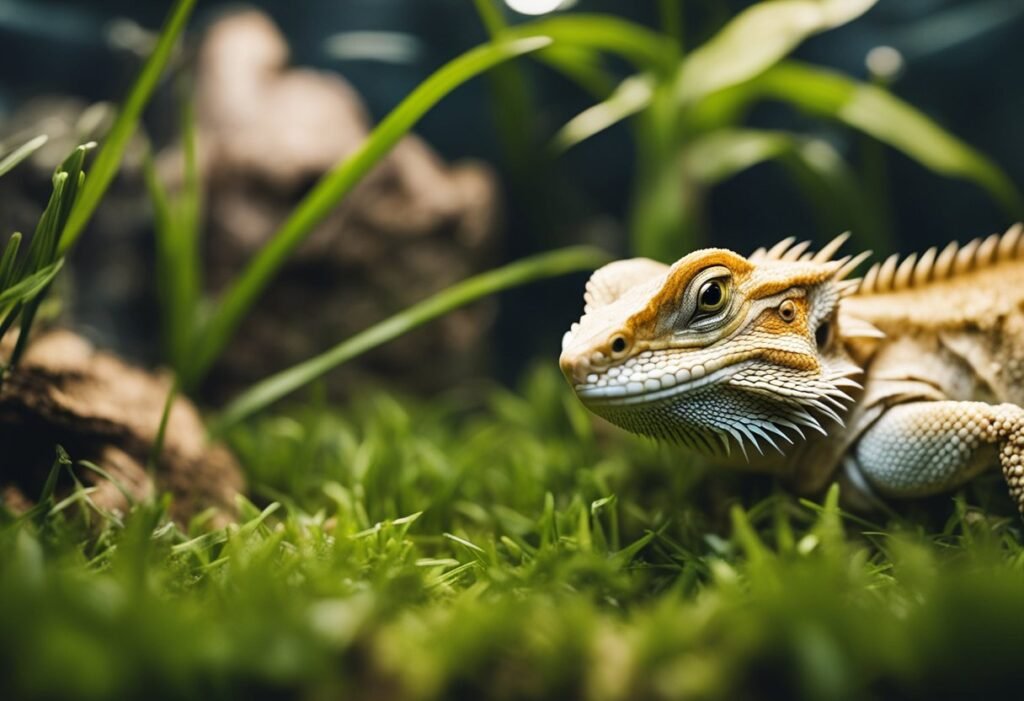
What are the best vegetables for a bearded dragon’s diet?
Bearded dragons require a variety of vegetables in their diet. Some of the best vegetables to feed them include collard greens, kale, mustard greens, turnip greens, and dandelion greens. These vegetables are high in calcium and other essential nutrients that bearded dragons need to thrive.
Are there any insects that bearded dragons should avoid?
Bearded dragons should avoid eating insects that are high in fat and low in nutrients, such as mealworms and superworms. Additionally, wild-caught insects should be avoided as they may have been exposed to pesticides or other harmful chemicals.
Which fruits are safe for bearded dragons to consume?
Bearded dragons can safely consume a variety of fruits in moderation. Some of the best fruits to feed them include strawberries, blueberries, raspberries, and mangoes. However, fruits that are high in sugar should be fed sparingly.
Are there any common garden plants that are harmful to bearded dragons?
Yes, there are several common garden plants that are toxic to bearded dragons. These include daffodils, lilies, tulips, and azaleas. It is important to research any plant before feeding it to your bearded dragon to ensure that it is safe.
Can bearded dragons safely eat commercially available greens?
Yes, commercially available greens such as collard greens, kale, and mustard greens are safe for bearded dragons to consume. However, it is important to avoid greens that have been treated with pesticides or other harmful chemicals.
What precautions should be taken when feeding bearded dragons plants from outdoors?
When feeding bearded dragons plants from outdoors, it is important to ensure that the plants have not been treated with pesticides or other harmful chemicals. Additionally, plants should be thoroughly washed and inspected for any signs of mold or disease before feeding them to your bearded dragon.
I, Mark Antonelli am highly interested in pet care tips. The experiences I gained through university life in animal sciences were also helpful to identify the best tricks for caring for and feeding varying kinds of pets. I know the majority of people love to own a pet. Yet, there is a guilty of owing a Bearded Dragon due to a lack of information about how much friendly and peaceful they are. I thought of filling this gap with detailed writings about this Pogona genus Bearded Dragon. All my team is also giving me great support to fulfil my mission. Hope you will enjoy the journey with us.

